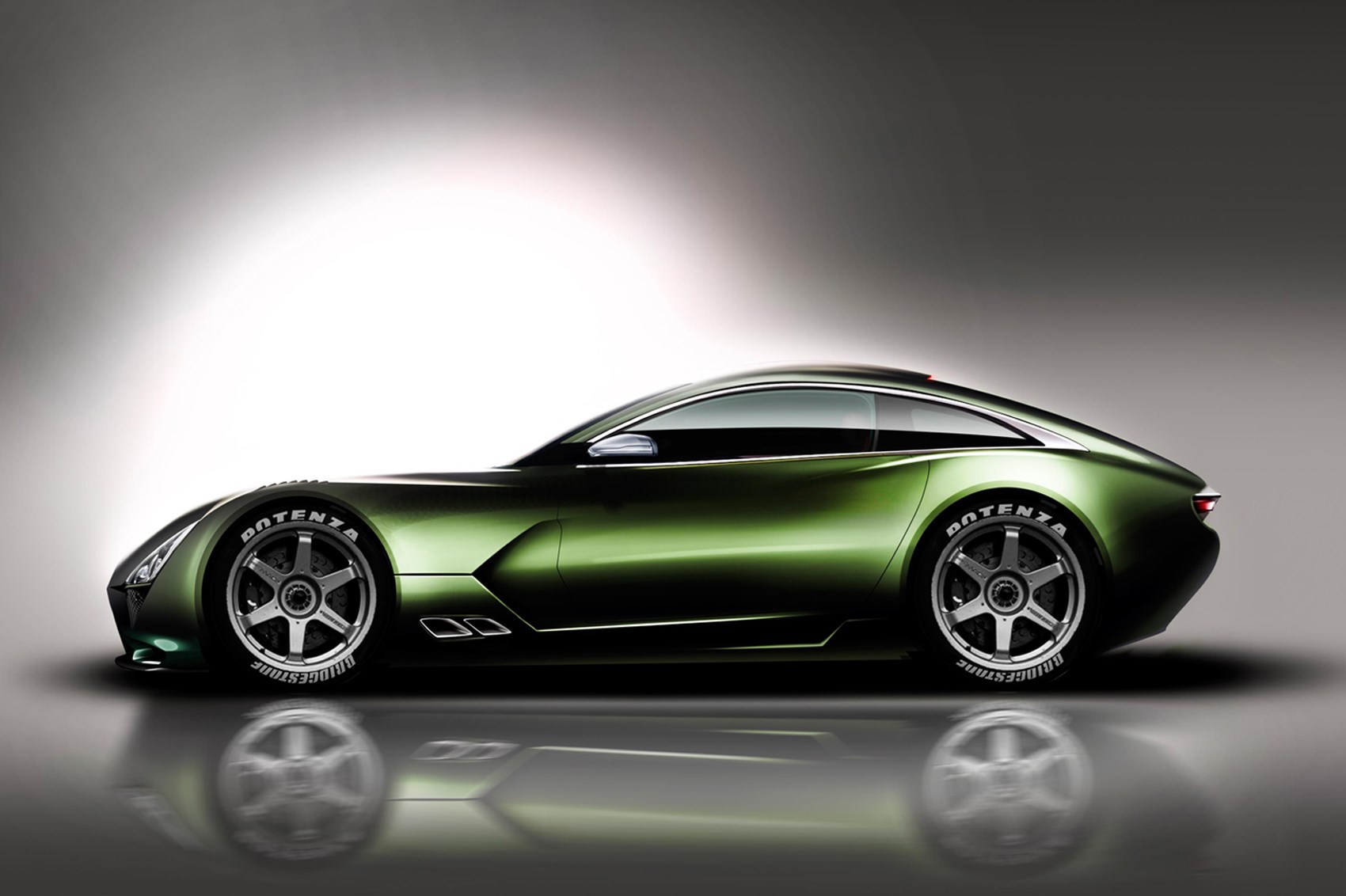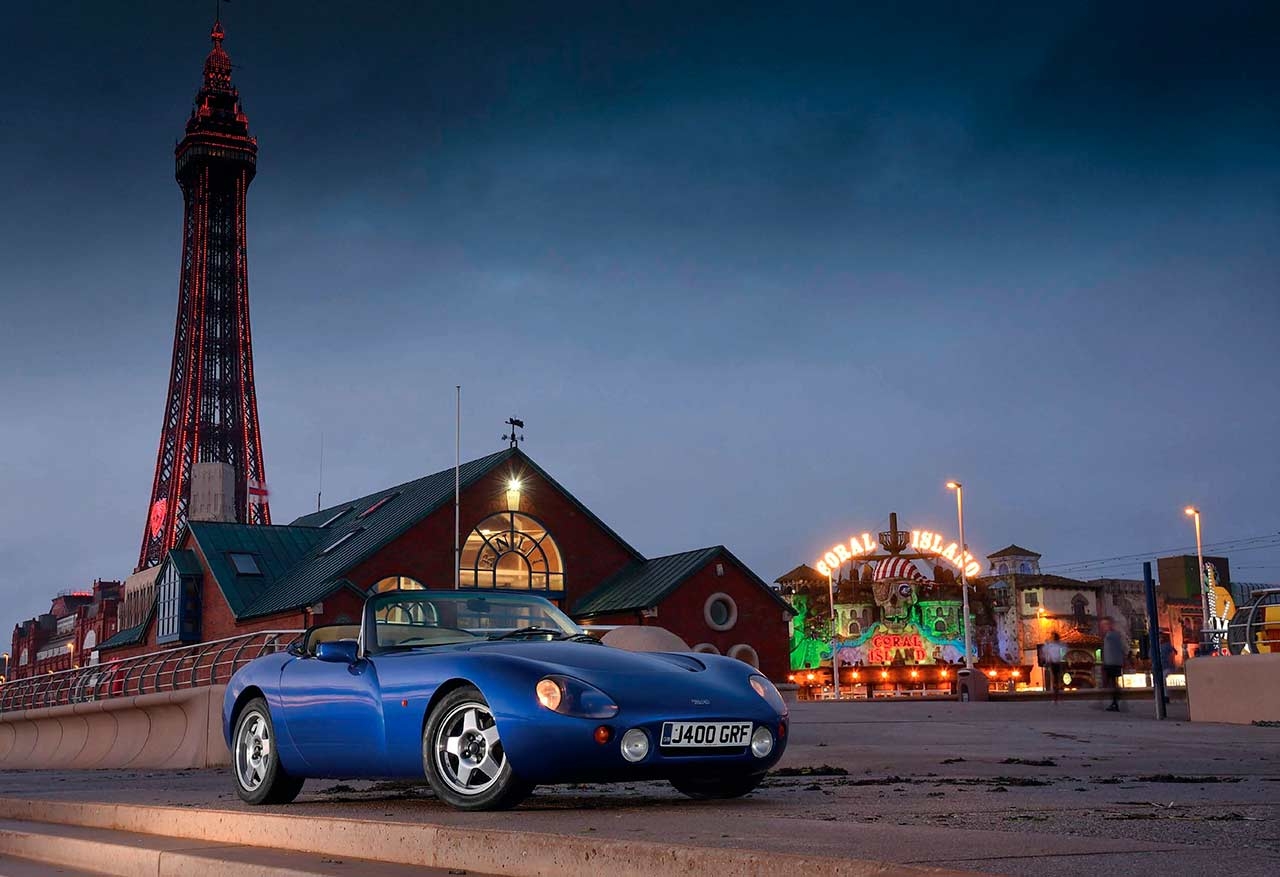
Griffith pilgrimage to Blackpool, as Britain’s most outrageous car maker hits 70 years. TVR heads home! Birthday Dash – Drive-My joins a trek to Blackpool to toast 70 years of TVR. Seven decades of TVR. We head to Blackpool in a Griffith to meet the keepers of the faith. Riding the TVR rollercoaster. As TVR marks its 70th birthday, the green shoots of revival are emerging. Greg MacLeman takes a Griffith on an emotional tour from past to future. Photography Neil Williams.
Cruising along the sprawling Blackpool promenade at dusk, with the reflection of a thousand lights from seafront amusements and sweet-shop signs dancing across the drizzle-spattered windscreen, this bleak northern town seems an unlikely home for one of Britain’s most loved low-production car manufacturers. And now the firm so inextricably bound to the seaside resort has found a new base in Wales following its most recent revival, the electric shock to the chest coming courtesy of video games developer and entrepreneur Les Edgar, plus a dozen associates.
On an overcast and blustery day, about 50 TVRs have returned to Blackpool for one last hurrah before thundering down to inaugurate the new factory site in Ebbw Vale, Gwent.
Former archivist and now club chairman Richard Sails tickles the throttle of his Griffith – an early 4.0-litre ‘pre-cat’ model later fitted with a 4.5-litre Big Valve engine – and pulls away from the lights. “I’ve only had the car for a couple of days,” he says, “but I’d been trying to buy it for 15 years. We agreed a price a couple of years ago, and now I’ve finally got it.” Another stab of the accelerator sends a deep bellow reverberating across the rain-soaked streets.
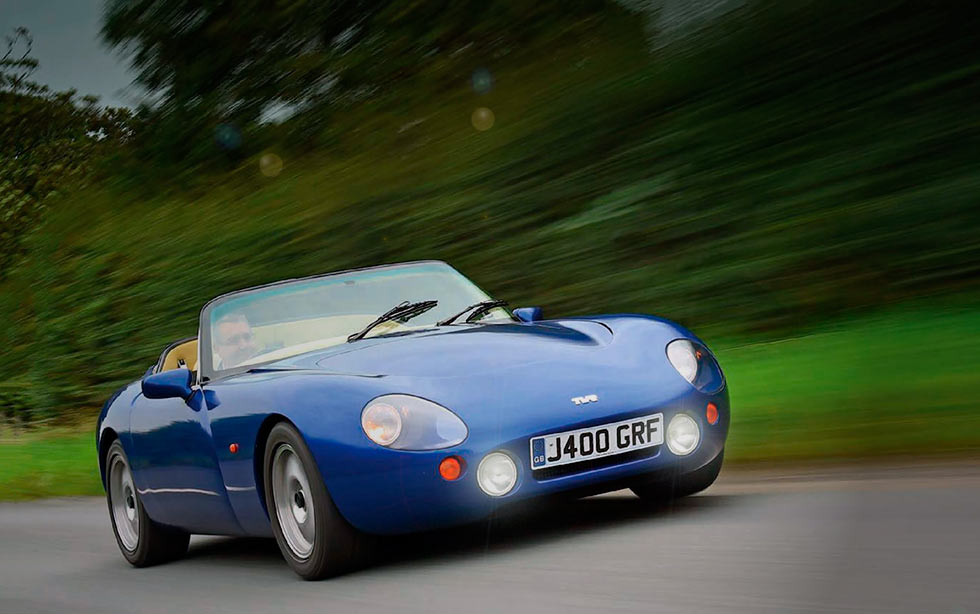
We set off from the south shore, heading a convoy of TVRs spanning 50 years of production, though the most commercially successful – and loudest – models are best represented. Holidaymakers braving the windswept promenade point and smile as the baritone V8 rumble of Chimaeras, Cerberas and Griffiths echoes around the Central and North Piers which, despite the grizzly weather, are teeming with life.
As dusk gives way to night we arrive at the Top Chippy on the north shore, and the surrounding roads quickly become overrun by glassfibre sports cars, every spare parking bay and expanse of pavement packed with TVRs and their enthusiastic owners. The fish-and-chip run isn’t glamorous, but it’s a fitting start to the ‘Back Home > New Home’ tour, masterminded by the TVR Car Club as a way to mark 70 years of TVR and to say goodbye to the old stomping ground – home to the firm since the early post-war years.
Much like Blackpool, whose fortunes have ebbed and flowed at the whim of an uncertain economy and changing consumer habits, TVR’s history is a patchwork of highs and lows, but is ultimately a truly British tale of survival. The story began with a certain Trevor Wilkinson’s first Alvis-based two-seater special in 1947, and within 10 years TVR Engineering had taken up residence on Blackpool’s Hoo Hill industrial estate. Despite quickly graduating from producing a handful of kit cars and specials to more than 100 Mk1 Granturas, however, the company struggled financially and by 1958 the firm had been dissolved, replaced by Layton Sports Cars. The cash flow and quality problems continued until the outfit was saved by TVR dealers Bryan Hopton and Keith Aitchison, and renamed TVR Cars Ltd in 1961. Trevor Wilkinson – the founder of the company and for whom it was named – was then sidelined by the other directors and eventually resigned.
Though there were certainly signs of life in terms of the much-improved Mk3 Grantura – which threw out the earlier car’s chassis and torsion-bar suspension in favour of independent front and rear wishbones – and even an outing at Le Mans in 1962, the concern folded the same year, buckling partly due to the Mk3’s late arrival. Incredibly, a creditor of TVR – Grantura Engineering – began turning out cars within a few months and a second company – Grantura Plastics – was founded to handle the bodyshells.
By April 1964, the brutally quick Ford 289cu in V8-powered Griffith 200 had arrived and, despite a growing reputation for poor build quality, it proved a huge hit in the States. The skies once again darkened for TVR in ’1965 as American dock strikes hampered Griffith exports, placing the firm under financial strain at a time when it was developing a brand-new model – the futuristic, wedge-shaped Trident – which it was hoped would transform the image of the company from its kit-car roots to a bona fide sports-car manufacturer. The stunning machine broke cover in Geneva that year, but failed to impress in the US. The crisis deepened when Grantura Engineering MD Arnold Burton lost patience with the company haemorrhaging money and turned off the tap. The doors were closed at Hoo Hill and Grantura Engineering was liquidated in September 1965.
Mere weeks passed before TVR dealers once again rescued the firm, this time Martin Lilley and his father, Arthur, who bought the company and renamed it TVR Engineering, returning the B-Series-engined Grantura 1800S to production in 1966 and launching the Tuscan V8 and Vixen the following year. The Lilleys pressed through a difficult period and led the move to a larger new facility at Bristol Avenue in Blackpool, and several new models followed.
As dawn breaks the following morning, the phalanx of TVRs once again gathers at Blackpool’s south shore, the rain of the previous evening having been blown away by a stiff sea breeze. More cars arrive before the cavalcade heads into the town, rumbling past the Tower then striking out into the suburbs, bound for an unassuming road of Victorian terraced houses that once marked the location of the company’s first workshop. Long-since forgotten, the Beverley Road site elicits little more than the odd sideways glance from drivers and a few quizzical looks from residents, no doubt wondering why their quiet morning has been punctuated by the din of gathering V8s.
It’s a similar story at the firm’s second home on the Hoo Hill industrial estate, and Bristol Avenue, where the main factory building now houses a gymnasium named ‘Bispham Body Senze’ and the only remnant of the building’s motoring heritage – aside from its instantly recognisable tall windows and imposing frontage – is a small window sticker sitting below where the large TVR sign was once attached. The move to Bristol Avenue took place in late 1970, marking the start of another turbulent period for TVR. The Tuscan V6 and Vixens were built here before the arrival of the M Series in 1971, but in ’75 it faced another setback when a nearcatastrophic fire, compounded by subsequent efforts to clean up the damage, destroyed several cars and valuable pieces of equipment.
The Lilleys managed to navigate the choppy waters of the 1970s, but by the end of the decade financial difficulties once again loomed over the operation. Cash-flow problems were amplified by a number of M Series cars being seized by the US government for infringing emissions regulations, while the all-new ‘wedge’ Tasmin, which was unveiled in 1980, was a lame – and expensive – duck that failed to sell in the required numbers. The British recession was the final nail in the coffin, leading Martin Lilley to transfer control of the ailing company to wealthy TVR enthusiast Peter Wheeler in 1981.
Under the charismatic Wheeler’s direction sales grew, with the success of the M-inspired S Series – not to mention a line of ever-loopier Rover V8-powered wedges – providing the platform to launch the marque’s most commercially successful models in the ’90s, beginning with the curvy Griffith and Chimaera. The factory had never been busier. Though those days are now a distant memory, parts of the sprawling Bristol Avenue site are still home to ex-TVR employees in the form, most notably, of Surface & Design. As the road outside the factory fills up with sports cars in a scene reminiscent of the firm’s zenith in the 1990s, there’s a chance to catch up with S&D director Chris McGuire.
“By 1994 we were building 39 cars a week,” says McGuire. “That’s when the Chimaeras and the Griffs came out and the orders went skyhigh. There were 700 people working here at that point and it was so busy. We had a separate line for the Cerbera and were doing about three or four of those per week. But the new Tuscans were then slow coming through, and a lot of people were made redundant.
“Sadly, the firm was bought by someone who didn’t want to continue building the cars for some reason and it all went south. We started up on our own in 2008 and we’re busier than ever. The bodyshop was out the back, which has all been knocked down now, while the building that we’re in was used for model development.”
Previous visitors to the site will no doubt have been transfixed by the part-finished bodyshells and bucks strewn around at the back of the works, but time marches on and they’ve since been removed. There’s a sense that the schism brought about by the collapse of the company is becoming a more distant memory as ex-factory workers continue the journey on their own.
The sharp bark of a Tuscan exhaust interrupts our conversation and sends owners hurrying back to their cars as once again the convoy of TVRs takes to the road, leaving yet another of the company’s famous landmarks in the rearview mirror. The sprint towards the village of Weeton takes the group past Victoria Hospital and Blackpool Zoo, where the last of the speed cameras stalling our progress can be left behind.
Eventually, the first cars enter Kirkham, pulling into the entrance of another former TVR building, now better known for its current occupant, X Works Service, which has become the go-to TVR specialist in the north of England. Though not as well known as the firm’s larger sites, the ‘TVR Barn’ nonetheless played an important role in its recent history, being the last premises in which the cars were built, latterly late-model Sagaris projects.
Owners Heath Briggs and Paul Forrest are well known to the TVR fraternity from their days in the factory service department, but they ended up going it alone after production ended in 2006. “Paul and I were doing clutches and the odd service on our driveways before we found a garage,” says Briggs. “I joined up with another guy before asking Paul to come and join me, we were that busy. TVR was still hounding us ‘will you work for us, will you work for us?’
“I relented, we moved into an old workshop and agreed to split the rent. We finished off their cars here, including Tuscan and Sagaris models. Then a car pulled up one day and the chap said ‘you’re all sacked’. The landlord was happy for us to take over the lease, and we’ve now been here for eight years. Nikolai [Smolensky, the Russian banker who bought the firm from Wheeler in 2004] was good to us in the end, and said that we could keep this and that, including the TVR sign, which we had bought after the dealership in Preston went under.”
The pair’s services are clearly in high demand, and as Paul crosses the road to a stricken S Series while Heath tends to another wounded TVR, we take the opportunity to set off on the next leg of the journey to the RAF Museum at Cosford, and give Sails’ Griffith a proper leg-stretch. Considering a list of modifications that increase power by about 50%, it remains remarkably compliant at low speeds and the clutch is lighter than you anticipate. But it’s at pace that a Griff truly comes into its own, and the twisting, undulating country lanes of rural Lancashire provide the perfect opportunity to loosen the reins. The naturally aspirated Rover V8 delivers power instantly and with ferocity and, rather than climbing to a crescendo, the exhaust is a relentless aural barrage broken only by the sharp rise in revs as the rear wheels lose traction on bumpy backroads.
It’s a comfortable tourer, too, and once we’ve had our fun we head for the motorway and turn south. The relatively unstressed engine sounds sweet at cruising speeds, wind noise being the only blot in its grand touring copybook – that and a thirst to rival George Best.
At Cosford, participants get another chance to socialise with fellow owners and inspect one another’s cars, and by now dozens more TVRs have joined the tour, including a number of older models. In many ways, the cars on display reflect the changing fortunes of the marque, with a lone Grantura sandwiched among the Chimaeras, Griffiths and Tuscans from the firm’s most prolific period. It also speaks of the passion that owners have for TVR, and it becomes clear that the enthusiasm and faith in the vehicles that led to so many owners and dealers rescuing the marque throughout the years is very much alive in the membership of the TVR Car Club.
From Cosford, dozens of TVRs set off to visit the site of the new factory and Ebbw Vale, where a gala dinner awaits, along with a track outing at Llandow Circuit and the hope of a glimpse of the new car ahead of its debut. The Gordon Murray/ Cosworth collaboration has members optimistic – albeit cautiously. But it’s here that we part company from the group, swapping the Griff’s intoxicating V8 burble for our soulless Korean camera car, and head back to London.
Whether the rebirth of the firm turns out to be a phoenix from the ashes or yet another reanimated corpse remains to be seen. One thing is for certain, however: TVR’s future is already assured by the thousands of TVRCC members keeping the spirit of the marque alive, and the thousands more who will hear that roar and know they simply have to have a TVR.
Photoshoot
‘THE SHARP BARK OF A TUSCAN EXHAUST HAS OWNERS SCURRYING BACK TO THEIR CARS’
‘A STAB OF THE ACCELERATOR SENDS A DEEP V8 BELLOW REVERBERATING ACROSS THE RAIN-SOAKED STREETS’
‘SALES OF THE S SERIES PROVIDED A PLATFORM TO LAUNCH TVR’S MOST SUCCESSFUL MODELS’
Clockwise, from top left: appropriate venue for a marque that was always more fish ’n’ chips than posh nosh; sunset over the pier; TVRs on the prom.
Late-model Sagaris blasts along the seafront. Top: though firmer than a Chimaera, the Griffith still blends searing pace with surprising civility.
Dawn patrol: owners gather on the south shore for the start of the Saturday tour from Blackpool to RAF Museum Cosford in Shropshire.
Clockwise, from above: brooding sky over Taimar; Griff doorhandles sited on the transmission tunnel; X Works Service lives in a former factory building.
Clockwise, from top left: mid-run fettling for Tuscan and Chimaera; Surface & Design lives in the Bristol Ave works; Chris McGuire shares TVR memories.
Pressing on in a Griffith demands care: it’s supple, but rear wheels are keen to break traction. Below: rally marks 70 years; all eras at RAF Cosford.
1962 TVR GRANTURA
One of the oldest cars at RAF Cosford was club stalwart Ian Massey-Crosse’s Mk3 Grantura, which is a fascinating link to the firm’s early history. “The improved chassis and suspension of the Mk3 work really well,” he says, “it’s lovely to drive. Later cars also have a 41/2in longer door, which makes all the difference when you’re getting out!”
An article by marque historian Peter Filby convinced Massey-Crosse to buy the TVR: “It ticked all the boxes. It had a tubular steel chassis, rust-free glassfibre body, front disc brakes and independent suspension. I got it in 1976, and repainted it in ’78. I chose white because I thought it would look slab-sided in a darker colour, though it was at various points orangey red, dark red and even gold.”
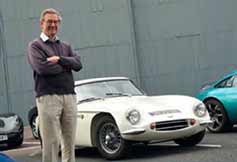
1978 TVR 3000M
Serial car collector Jeff Sargeant and wife Carol have a long association with their M Series: “I ordered the car in 1978 and went to see it being made,” he says. “I got it in a slightly different spec – I think it was the first one to ever have a white vinyl roof.
“My wife and I married in 1979 and the car was suitably dressed-up with toilet rolls and shaving cream. I’ve done about 170,000 miles since, and recently had it fully rebuilt.”
The TVR is one of five in his double-figure car collection, which includes two wedges, an S3 and a Chimaera: “A good friend of my father advised me when I was about six years old that if I kept all the cars I’d ever own they’d be worth a fortune, and I’ve been fortunate enough not to have to sell any!”
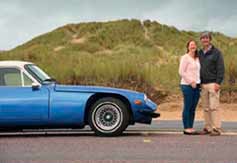
1978 TVR 3000S
As the group gathers at X Works Service, one car draws more attention than most: Alan Preston’s stunning 3000S. “I’ve had it five and half years,” he says. “The previous owner rebuilt some of the car, and I finished it off. It was road-legal, but smoked badly and the gearbox and rear axle were in a bad way. I ripped it all out and started again.”
Incredibly, the smart paint is 20 years old, but beneath the glassfibre Preston has been busy: “It’s bored out to 3.1 litres, with a hotter cam and the heads ported and polished. I did all the work myself and it’s also fitted with a four-speed ’box and single carburettor, which make it very drivable. As long as you’re mechanically minded and can do a bit of work, you’ll be fine with a TVR.”
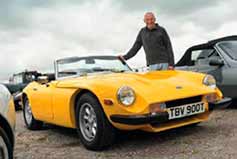
1984 TVR TASMIN
Sharp-eyed readers might just recognise Jez Barker’s Tasmin, because it was once owned by Drive-My’s Al Clements. “I was after a V8S, but that was out of my price range,” says Barker. “Then I saw this, which I’d seen in Drive-My. After a quick drive I was sold! “The battery failed on the way home, but we got it started and managed to get back. Since then, the engine’s been rebuilt, it’s had new brakes and a bit of rewiring. The chassis outriggers were replaced and the car has been repainted in a VW Scirocco green.”
So what drew Barker to TVRs in the first place? “It has to be the noise,” he says. “After that, they’re easy to work on, quick if you want them to be, and reasonably reliable. And the bodies don’t rust!”

1988 TVR S
Locals Sue Carlin and Alan Baguley drove to RAF Cosford from near Telford, meeting a number of crews at Whitchurch before following them to the Museum. Sue’s original S has been in the family for four years. “My husband saw me in a wedge,” she says, “but I didn’t like them and eventually bought this car at Brightwells. It was first sold to a young David Abdoo of Thames Television.
“It came with a fresh MoT, but there were lots of issues. We sorted the suspension and fuel system – the engine’s now giving better performance than when Ford sold it to TVR. This winter we’re in for a new fuel tank, and the seats need replacing. We won’t take it off the road to do it all at once because it’s too costly – and I enjoy driving it too much!”
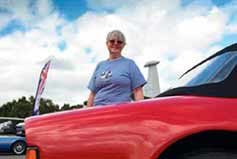
1996 TVR CHIMAERA
Loud colours became a TVR trademark in the ’90s, and Alan Musgrave’s highly original and very bright Chimaera is no exception. “I’ve owned the car for 16 years and it hasn’t needed anything beyond regular servicing,” says Musgrave. “You hear horror stories – and some that came out of the factory were not great – but most have now been sorted.
“They’re entertaining to drive quickly, but you can also trundle along at 40mph. I look at the Chimaera as a GT car, and we’ve taken it to Le Mans and the Spa-Classic. You can easily cover 3-400 miles in a day without feeling you’ve been bounced around.”
Bitten by the bug, Musgrave now plans to add an 11,000-mile Tuscan to his fleet: “I’ll use that and my wife can have the Chimaera!”

2000 TVR TUSCAN
When he’s not working on customers’ TVRs, Heath Briggs is fettling his own fleet – the Tuscan and a 1996 Chimaera that served as the factory demonstrator: “I used to take people out in it at the factory and always wondered who the hell specced it in gold and brown – they called it The Twix!”
The low-mileage Tuscan is kept for best: “It was standing outside a house for 10 years and I must have spent £10k on parts – never mind the labour! The first owner ordered it in Aston Martin BRG after Aston stopped making the car he wanted. I believe he took it out one winter and slid it into a bin wagon. It must have shaken him up, so he parked it on the drive and never came back. It had only 3600 miles on the clock when I got it.”
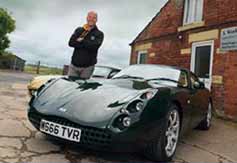
2005 TVR SAGARIS
For outright performance, it’s hard to see beyond TVR’s most recent model, as Sagaris owner Nick Bell explains: “You sit in it and the hairs on the back of your neck rise. That is how a sports car should make you feel.
“I started thinking about TVRs when the Griff came out, but it wasn’t until I was made redundant that I had the ability to buy a sports car. I looked at a 308 and 911, but the Porsche was too efficient and the Ferrari too expensive. I was going to get a Tuscan because it has a boot, but my wife said I might as well buy the car I really wanted.
“The Sagaris is easy enough to drive, but it’s taken a while to get used to the power – you open the throttle and you need to know how it’s going to react to bumps and bends.”

TVR: the return
The first new TVR since the Sagaris is slated to break cover at this year’s Goodwood Revival, and the spec sheet is enough to make even the most cynical enthusiast sit up and take notice. TVR claims that the coupé will cost less than £90,000, will have a top speed of 200mph, and will sprint from 0-60mph in less than 4 secs.
And, of course, it will have a manual gearbox. The new model is expected to tip the scales at 1200kg, thanks to Gordon Murray’s patented ‘iStream Carbon’ production process, which uses a tubular structure with bonded-in carbonfibre panels, while power comes via a Cosworthtuned, Mustang-sourced 5-litre V8, giving the front-engined two-seater a power-to-weight ratio of 400bhp per tonne – better than a Porsche 911 turbo S, an Aston Martin Vantage GT8 or a Jaguar F-type SVR. The TVR also promises to be more compact than its rivals.
The car will be revealed to the public for the first time in the Revival’s Earls Court display, where it will sit alongside several classic TVRs. Just 500 Launch Edition cars will be available, but most of those have already been sold so if you want one, you’ll have to be quick!
